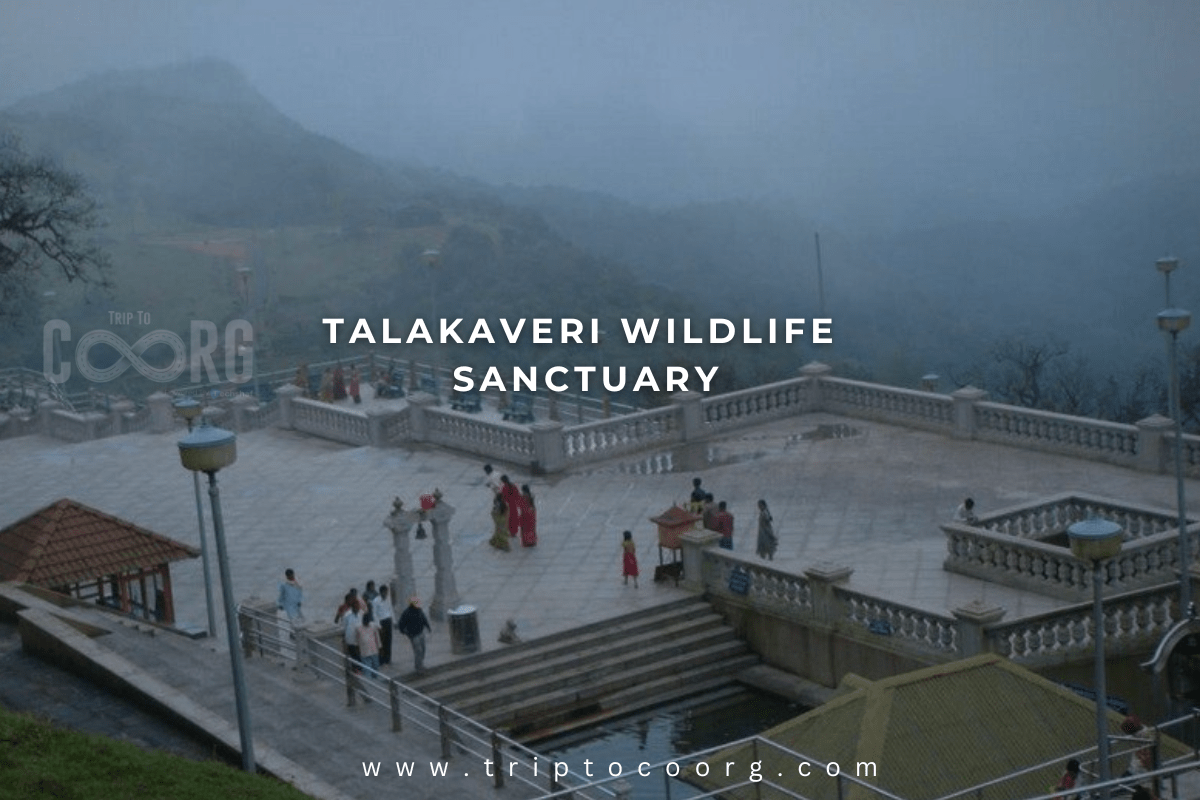Introduction
Talakaveri Wildlife Sanctuary, located in the Coorg (Kodagu) district of Karnataka, India, is a protected area adjacent to the Talakaveri Temple. It is known for its rich biodiversity and scenic landscapes. The Tala Kaveri Wildlife Sanctuary is a captivating destination for nature lovers and wildlife enthusiasts.The sanctuary is home to a variety of wildlife, including Indian elephants, tigers, leopards, and various species of deer. It also hosts a range of bird species, reptiles, and plant life. Spanning an area of approximately 105 square kilometers, this sanctuary is not only a haven for a diverse range of flora and fauna but also a serene retreat that offers an immersive experience in the heart of the Western Ghats.Talakaveri Wildlife Sanctuary is located in the Coorg (Kodagu) district of Karnataka, India. Tala Kaveri Wildlife Sanctuary is strategically positioned around the source of the River Kaveri, which is one of the most sacred rivers in India. The sanctuary is named after Tala Kaveri, the origin point of this river, which is a revered pilgrimage site. The sanctuary’s lush forests and rolling hills create a scenic landscape that attracts both tourists and conservationists alike.
Distance: Here are the approximate distances from major locations to Talakaveri Wildlife Sanctuary: From Madikeri: About 48 kilometers (30 miles). The drive typically takes around 1 to 1.5 hours. From Bangalore: Approximately 270 kilometers (168 miles). The drive usually takes around 5 to 6 hours, depending on traffic and road conditions. From Mysore: Around 120 kilometers (75 miles). The drive generally takes about 3 to 4 hours. These distances make Talakaveri Wildlife Sanctuary accessible for visitors traveling from nearby towns and cities, offering a scenic journey through the Western Ghats.
Talakaveri Wildlife Sanctuary is famous for several reasons:
- Rich Biodiversity: Flora and Fauna: The sanctuary is home to a diverse range of wildlife, including Indian elephants, tigers, leopards, and various species of deer. It also supports a variety of bird species and plant life, making it a significant area for biodiversity.
- Ecological Significance: Western Ghats: Located in the Western Ghats, a UNESCO World Heritage Site, the sanctuary is part of one of the world’s most important biodiversity hotspots. Its unique ecological setting contributes to its significance in terms of conservation and environmental health.
- Scenic Beauty: Natural Landscapes: The sanctuary features lush forests, rolling hills, and scenic landscapes. The picturesque environment enhances the experience for visitors and provides excellent opportunities for nature photography and wildlife observation.
- Proximity to Talakaveri Temple: Religious and Cultural Importance: The sanctuary is located near the Talakaveri Temple, which is the source of the River Kaveri. The combination of natural beauty and religious significance adds to the sanctuary’s appeal.
- Conservation Efforts: Protected Status: As a protected wildlife sanctuary, it plays a crucial role in conserving the region’s flora and fauna. Conservation programs and efforts are focused on preserving the habitat and wildlife of the sanctuary.
- Trekking and Nature Walks: Outdoor Activities: For those interested in exploring the sanctuary up close, The sanctuary offers opportunities for trekking and nature walks, allowing visitors to explore its diverse ecosystems and enjoy its natural beauty up close.
- Unique Ecosystems: Diverse Habitats: The sanctuary encompasses a range of ecosystems, from dense forests to grasslands, each supporting different types of wildlife and plant species. This diversity makes it an interesting destination for ecologists and nature enthusiasts.
The ideal time to visit Tala Kaveri Wildlife Sanctuary is between October and March when the weather is pleasant and conducive to outdoor activities. Comfortable walking shoes, binoculars for birdwatching, and a camera are essential. It’s also advisable to carry a hat, sunscreen, and insect repellent. Opting for a guided tour can enhance the experience, as guides offer valuable insights into the sanctuary’s wildlife and flora. To ensure the preservation of the sanctuary, it is important to follow all guidelines, avoid disturbing wildlife, and take care not to litter.
Conclusion: Tala Kaveri Wildlife Sanctuary is a testament to the natural splendor and ecological significance of the Western Ghats. Its diverse wildlife, lush forests, and serene landscapes offer a perfect retreat for nature enthusiasts and those seeking a connection with the natural world. Whether you are visiting for its sacred significance, its rich biodiversity, or simply to enjoy its serene environment, Tala Kaveri Wildlife Sanctuary provides an unforgettable experience that underscores the beauty and importance of conservation.


0 Comment